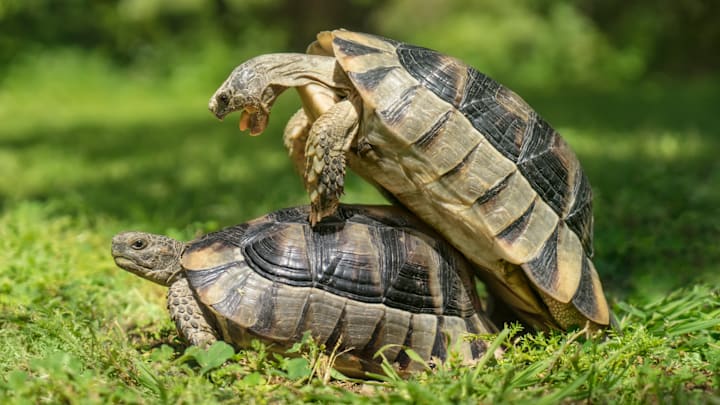Homo sapiens does not have a monopoly on strange sex. Peculiar mating rituals are prevalent throughout the animal kingdom. While writing my book, Sex Weird-o-Pedia: The Ultimate Book of Shocking, Scandalous, and Incredibly Bizarre Sex Facts, these were the 10 most interesting animal sex facts I came across, down below.
1. Turtle mating sounds make for good special effects.
It turns out that animal mating sounds can be really useful for capturing people’s attention. When the filmmakers of Jurassic Park wanted to create velociraptor sounds, they used recordings of tortoises getting it on.
2. Sharks have versatile birthing methods.

Australian scientists claim to have found a shark that gives virgin births. They studied a female zebra shark named Leonie, who laid eggs despite not being around a male shark in three years. Several years before her virgin birth, Leonie gave birth after mating with a male shark.
She’s not the only zebra shark to have used her own genetic material to fertilize eggs. A zebra shark named Bubbles reportedly did so in 2008 at the Shedd Aquarium in Chicago.
3. Worms have really long dry spells.
You think it’s been a long time since you’ve been intimate with someone? You’ve got nothing on worms. After sequencing the DNA of asexual translucent worms, NYU researchers discovered that one species, Diploscapter pachys, had not had sex for about 18 million years. This makes Diploscapter pachys one of the oldest known asexually reproductive species.
4. Fine fragrances turn big cats on.

Calvin Klein fragrances have sex appeal to animals, too. Captive tigers and jaguars have become stimulated by the brand’s Obsession for Men scent. Forest rangers have used the scent to lure tigers out of the wild.
5. Barnacles have adaptable penises.

Barnacles may have the most interesting penises in the animal kingdom. Their penises can stretch up to eight times the length of their body. And while many species’ manhoods can change size, few can alter their shape.
But researchers in Alberta found that barnacles that live in gentle waters have long and thin penises that are good for reach, while those in rough waters have short and wider penises that are better for holding off strong waves. The researchers then transported rough water barnacles to calmer waters and vice versa and found that after getting moved around, the barnacles adjusted their penis’s shape to better fit their environment.
6. Water bugs mate loudly.
The water bug species Micronecta scholtzi is the loudest animal in the world relative to its size. The tiny critters reach nearly 100 decibels when they rub their penises against their abdomens. Basically, there is a rock concert going on whenever this bug releases a mating call.
7. Ducks defend themselves with their vaginas.

Duck penises can be terrifying: They are long and corkscrew-shaped and they can be used like a lasso to pull in females who are trying to escape unwanted advances. To fend off unwelcome mating attempts from overeager males, female ducks have evolved vaginas that twist in the opposite direction of their male counterparts’s corkscrew penises. Discover magazine referred to duck vaginas as “organic chastity belts."
8. Most birds don’t have penises.

Just 3 percent of bird species have penises. Ostriches and ducks have them, but eagles and penguins do not. When birds get erections, their penises fill up with lymph fluid instead of blood. Birds without penises transfer sperm from male to female via what is known as a “cloacal kiss.”
9. Male birds are desperate to impress potential mates.
As long as humans have been on Earth, guys have done incredibly stupid things to try to impress women. Male birds are not immune to this dynamic.
Little birds like chickadees will group together to take on larger predators. It has generally been assumed that they do this for protection purposes, but researchers in Brazil came to a different conclusion: The researchers created a few fake owls, one from a species that regularly eats smaller birds and another from a less threatening owl species. They found that across 79 different species of small birds, the less threatening owl was attacked more often by the smaller birds. Their conclusion was that the small birds used the weaker opponent as an opportunity to showcase their defense skills to potential mates.
10. Unlike humans, animals have gotten frisky in space.
According to NASA, no humans have ever had sex in space. But other animal species have been more active with their reproductivity outside our atmosphere.
The first pregnant mammals to fly in space aboard a U.S. spacecraft were rats, and frogs have conceived in orbit.
In an effort to better understand how reproduction works in the absence of gravity, Russia’s space agency launched five geckos into orbit in 2014 so that they could observe how the lizards had sex in space. Sadly, the geckos froze to death before they touched back down to Earth.
In 2018, NASA scientists began a mission that involved sending human and bull sperm to space. Their intention was to study how microgravity affects the motility of sperm cells. Because if humans are to ever colonize space, we must boldly bone where no one has boned before.
A version of this article was originally published in 2019 and has been updated for 2023.
